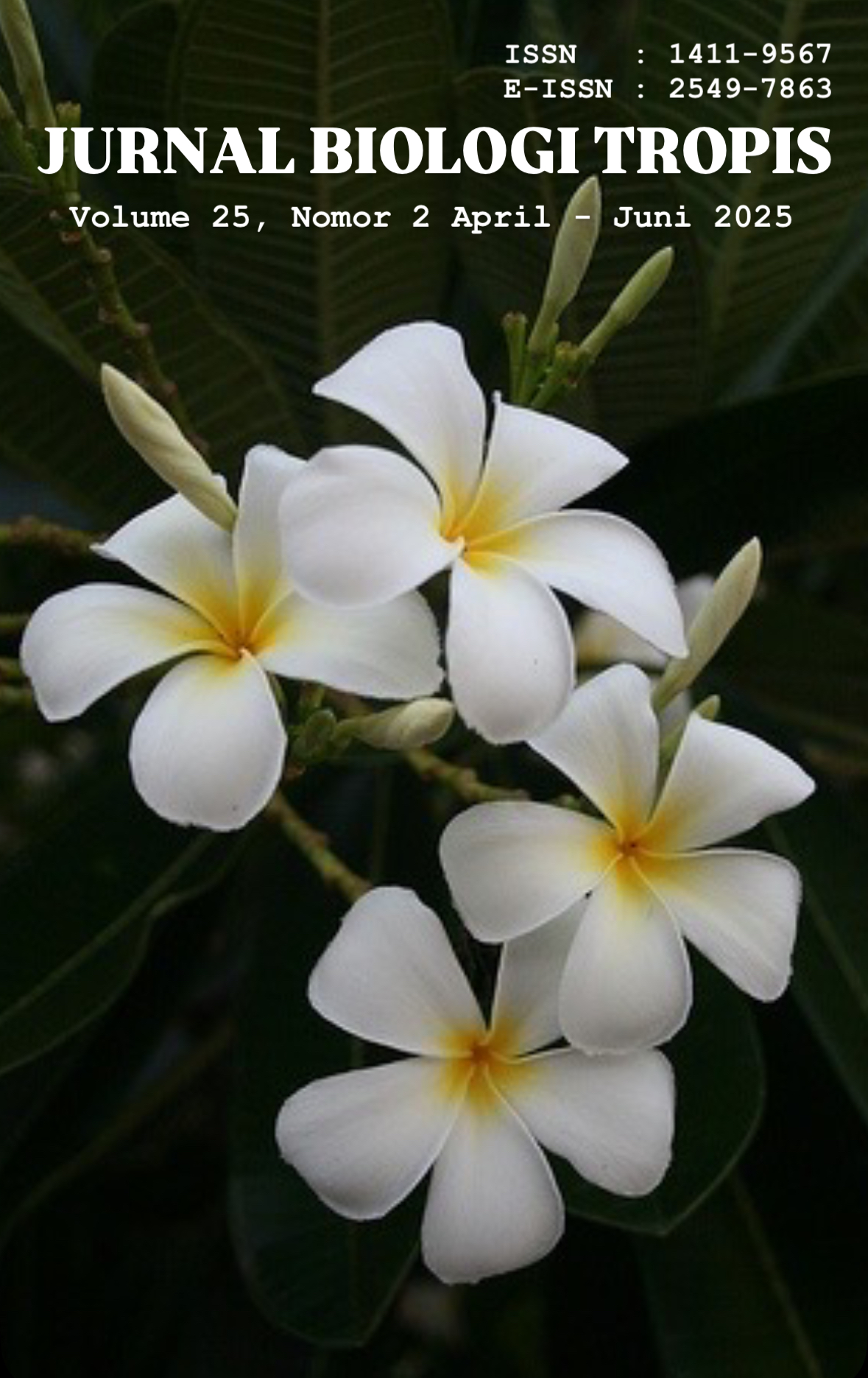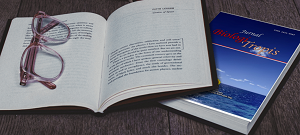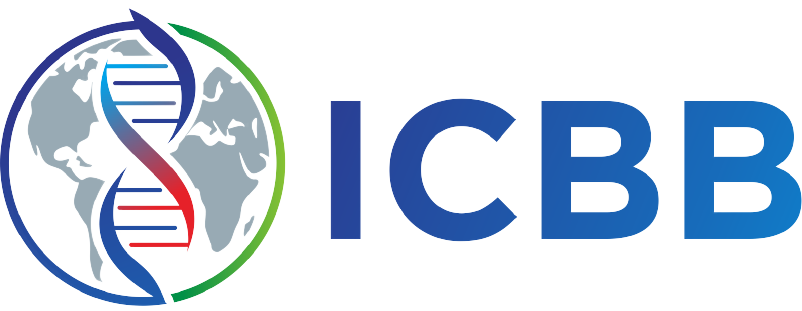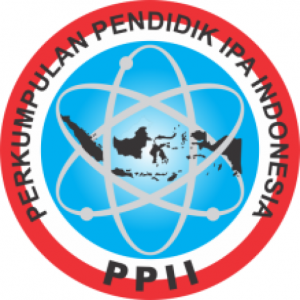The Effect of Depth on Carrageenan Content in Kappaphycus alvarezii Culture in the Waters of Teluk Gerupuk
Authors
Kuratul Aini , Nunik Cokrowati , Rangga Idris AffandiDOI:
10.29303/jbt.v25i2.9090Published:
2025-05-21Issue:
Vol. 25 No. 2 (2025): April-JuniKeywords:
Carrageenan, Depth, Kappaphycus alvarezii.Articles
Downloads
How to Cite
Downloads
Metrics
Abstract
Kappaphycus alvarezii is a red seaweed commonly found in the Indo-Pacific region. Seaweed plays an important role in daily life due to its high nutritional value and its content of hydrocolloid compounds such as carrageenan, agar, and alginate. Carrageenan is categorized into three types: iota, kappa, and lambda. It is widely applied in various sectors including food, pharmaceuticals, and cosmetics. This study aimed to identify the optimal cultivation depth to maximize the carrageenan content in Kappaphycus alvarezii. The research employed an experimental method using different depth treatments over a cultivation period of 45 days. A completely randomized design (CRD) was applied, consisting of four treatments with three replications, resulting in a total of 12 experimental units. The treatments were as follows: P1 (0 cm depth), P2 (25 cm), P3 (50 cm), and P4 (75 cm). The research procedure included the construction of floating rafts, seedling preparation, tying of seedlings, planting, sampling, and harvesting. The best results were observed in treatment P1 (0 cm depth), which yielded the highest carrageenan content at 40%, the greatest absolute weight at 350 grams, and the highest specific growth rate at 5.90% per day.
References
Andiska, Irawan, H., & Wulandari, R. (2021). Pengaruh Kedalaman terhadap Pertumbuhan Rumput Laut Kappaphycus Alvarezii Menggunakan Metode Longline. In Intek Akuakultur (Vol. 5).
Aqmal, A., Iswahyuddin, I., Purwanti, A., & Muriati, S. (2022). Comparison Of Artificial And Natural Light Intensity On The Growth Of Seaweed (Kappaphycus sp.) In A Controlled Tub. Klasikal: Journal of Education, Language Teaching and Science, 4(3), 831-837. https://doi.org/DOI:https://doi.org/10.52208/klasikal.v4i3.983
Aris, M., & Muchdar, F. (2020). Hubungan Kedalaman Perairan Dengan Kandungan Kappa-Karaginan Rumput Laut Kappaphycus alvarezii Relationship Between Depth And Kappa-Carrageenan.
Arjuni, A., Cokrowati, N., & Rusman, R. (2018). Pertumbuhan Rumput Laut Kappaphycus alvarezii Hasil Kultur Jaringan. Jurnal Biologi Tropis, 18(2), 216–223. https://doi.org/10.29303/jbt.v18i2.740
Asni, A. (2015). Analisis poduksi rumput laut (Kappaphycus alvarezii) berdasarkan musim dan jarak lokasi budidaya di perairan kabupaten bantaeng. Jurnal Akuatika Indonesia, 6(2), 140-153.
Calari, R. P., Diniarti, N., & Scabra, A. R. (2019). Pengaruh Perbedaan Kedalaman Terhadap Kandungan Klorofil dan Rendemen Karaginan Kappaphycus alvarezii Effect of Depth Differences on Chlorophyll Content and Carrageenan Yield of Kappaphycus alvarezii. In Journal of Marine Research.
Cokrowati, N., Apriliyanti, F., Nuryatin, N., Jayusri, J., Junaidi, M., & Asri, Y. (2024). Seaweed and its antioxidant content at Batu Layar beach, Senggigi, West Lombok Regency. Depik, 13(3), 494–507. https://doi.org/10.13170/depik.13.3.40014
Cokrowati, N., Diniarti, N., Setyowati, D. N., & Mukhlis, A. (2020). Pertumbuhan Rumput Laut dan Rumput Laut Lokal Hasil Kultur Jaringan Kappaphycus alvarezii. Jurnal Biologi Tropis, 4(1), 61–65.
Cokrowati, N., Diniarti, N., Setyowati, D. N., Waspodo, S., & Marzuki, M. (2019). Ekplorasi Dan Penangkaran Bibit Rumput Laut (Eucheuma cottonii) Di Perairan Teluk Ekas Lombok Timur. Jurnal Biologi Tropis, 19(1), 51–53. https://doi.org/10.29303/jbt.v19i1.994
Cokrowati, N., Lumbessy, S. Y., Diniarti, N., Supiandi, M., & Bangun, B. (2020). Kandungan Klorofil-A Dan Fikoeritrin Kappaphycus alvarezii Hasil Kultur Jaringan Dan Dibudidayakan Pada Jarak Tanam Berbeda. Jurnal Biologi Tropis, 20(1), 125–131. https://doi.org/10.29303/jbt.v20i1.1802
Dean, C., Sunadji, S., & Oedjoe, M. D. R. (2023). Kandungan Nutrisi dan karaginan Rumput Laut (Kappaphycus alvarezii) dari Perairan Semau Kabupaten Kupang. Jurnal Vokasi Ilmu-Ilmu Perikanan (Jvip), 4(1), 11-18.
Desiana, E., & Hendrawati, T. Y. (2015). Pembuatan Karagenan dari Eucheuma cottoni dengan Ekstraksi KOH Menggunakan Variabel Waktu Ekstraksi. Seminar Nasional Sains Dan Teknologi, November, 1–7.
Fikri, M., Rejeki, S., & Widowati, L. L. (2015). Produksi Dan Kualitas Rumput Laut (Eucheuma cottonii) Dengan Kedalaman Berbeda Di Perairan Bulu Kabupaten Jepara. Journal of Aquaculture Management and Technology, 4(2), 67–74.
Ikhsan, F., Irawan, H., & Wulandari, R. (2022). Laju Pertumbuhan Rumput Laut Kappaphycus alvarezii Varietas Hijau dan Coklat Pada Metode Budidaya yang Berbeda. Intek Akuakultur, 6(1), 82–91.
Irawati, B. A., & Affandi, R. I. (2024). Kultur jaringan rumput laut Kappaphycus alvarezii dengan metode embriogenesis somatik. Ganec Swara, 18(1), 358-368. https://doi.org/DOI:10.35327/gara.v18i1.768
Khasanah, U. (2013). Analisis kesesuaian perairan untuk lokasi budidaya rumput laut eucheuma cottonii di Perairan Kecamatan Sajoanging Kabupaten Wajo.
Kumayanjati, B.-, & Dwimayasanti, R. (2018). Kualitas Karaginan dari Rumput Laut Kappaphycus alvarezii pada Lokasi Berbeda di Perairan Maluku Tenggara. Jurnal Pascapanen Dan Bioteknologi Kelautan Dan Perikanan, 13(1), 21–32. https://doi.org/10.15578/jpbkp.v13i1.490
Lopes, L. A. F., Liufeto, F. C., & Salosso, Y. (2022, September). Pengaruh Kualitas Air Terhadap Laju Pertumbuhan Rumput Laut (Eucheuma cottonii). In Seminar Nasional Fakultas Peternakan, Kelautan, dan Perikanan (Vol. 1, No. 1, pp. 173-177). https://conference.undana.ac.id/fpkp
Mudeng, J. D., Kolopita, M. E., & Rahman, A. (2015). Kondisi lingkungan perairan pada lahan budidaya rumput laut Kappaphycus alvarezii di Desa Jayakarsa Kabupaten Minahasa Utara. e-Journal BUDIDAYA PERAIRAN, 3(1). https://doi.org/DOI:https://doi.org/10.35800/bdp.3.1.2015.6953
Nur, A. I., Syam, H., & Patang, P. (2016). Pengaruh kualitas air terhadap produksi rumput laut (Kappaphycus alvarezii). Jurnal Pendidikan Teknologi Pertanian, 2(1), 27-40.
Pakniany, F., Dahoklory, N., & Turupadang, W. (2023). Analisis rendemen dan jenis karaginan dari rumput Kappaphycus alvarezii di Perairan Maluku Barat Daya, Provinsi Maluku. JURNAL VOKASI ILMU-ILMU PERIKANAN (JVIP), 3(2), 115-119. https://doi.org/DOI:http://dx.doi.org/10.35726/jvip.v3i2.2149
Pauwah, A., Irfan, M., & Muchdar, F. (2020). Analisis Kandungan nitrat dan fosfat untuk mendukung pertumbuhan rumput laut Kappahycus alvarezii yang dibudidayakan dengan metode longline di Perairan Kastela Kecamatan Pulau Ternate Kota Ternate. Hemyscyllium, 1(1). https://doi.org/https://doi.org/10.29244/jitkt.v14i1.37659
Prayudha, M. R., Pramesti, R., & Susanto, A. B. (2024). Pertumbuhan Rumput Laut Kappaphycus alvarezii (Doty, 1985) dengan Metode Lepas Dasar. JURNAL ENGGANO, 9(2), 208-215. https://doi.org/10.31186/jenggano.9.2.208-215
Raihanun, B., Junadi, M., & Cokrowati, N. (2022). Pengaruh Kedalaman pada Budidaya Rumput Laut Kappaphycus alvarezii Yang Ditanam dengan Sistem Kantong The Effect of Depth on Kappaphycus alvarezii Cultivation of Seaweed Grown With the Bag System. Jurnal Airaha, 11(02), 209–218.
Rizqi, M., Cokrowati, N., Marzuki, M., No, J. P., & No, J. P. Pengaruh Penanaman Dengan Kedalaman Yang Berbeda Terhadap Kualitas Karaginan Rumput Laut Eucheuma cottonii. (Issue 37).
Safia, W., Budiyanti, & Musrif. (2019). Pertumbuhan Dan Kandungn Karaginan Rumput Laut (Euchema cottonii) Dengan Menggunakan Pengembangan Metode Rakit Gantung Pada Kedalaman Berbeda. Seminar Nasional Sinergitas Multidisiplin Ilmu Pengetahuan Dan Teknologi, 2, 101–108. https://www.jurnal.yapri.ac.id/index.php/semnassmipt/article/view/89
Santoso, L., Yudha, D., & Nugraha, T. (2008). The Controlling of “Ice-ice” Disease to Increase Seaweeds Production in Indonesia. In Jurnal Saintek Perikanan (Vol. 3, Issue 2).
Sapitri, R. A., Cokrowati, N., & . R. (2016). Pertumbuhan rumput laut Kappaphycus alvarezii hasil kultur jaringan pada jarak tanam yang berbeda. Depik, 5(1). https://doi.org/10.13170/depik.5.1.3843
Syahrul, N. A. (2021). Analisis Mutu Kimia Karaginan yang Dihasilkan pada Proses Produksi dengan Metode Alkali Panas= Chemical Quality Analysis of Carrageenan Generated in The Production Process with Hot Alkaline Method (Doctoral dissertation, Universitas Hasanuddin).
Tuiyo, R., & Moo, Z. A. (2023). Kandungan Karagenan Dan Kekuatan Gel Kappaphycus alvarezii Hasil Budidaya Teknologi Kultur Jaringan Secara Massal Basmingro. Jambura Fish Processing Journal, 5(1), 27–35.
Yolanda, N. T., & Agustono, A. (2020). Proses Ekstraksi dan Karakterisasi Fisiska Kimia Bubuk Agar Gracilaria sp. Skala Laboratorium di PT. Java Biocolloid Surabaya. Journal of Marine and Coastal Science, 7(3), 127–138. https://doi.org/10.20473/jmcs.v7i3.20740
Yuliati, M. A., Oedjo, D. R., & Rebhung, F. (2023). Pengaruh Penggunaan Kantong Jaring dengan Mata Jaring yang Berbeda Terhadap Pertumbuhan Rumput Laut (Kappaphycus alvarezii). JVIP, 4(1). https://doi.org/DOI:http://dx.doi.org/10.35726/jvip.v4i1.7126
License
Copyright (c) 2025 Kuratul Aini, Nunik Cokrowati, Rangga Idris Affandi

This work is licensed under a Creative Commons Attribution 4.0 International License.

Jurnal Biologi Tropis is licensed under a Creative Commons Attribution 4.0 International License.
The copyright of the received article shall be assigned to the author as the owner of the paper. The intended copyright includes the right to publish the article in various forms (including reprints). The journal maintains the publishing rights to the published articles.
Authors are permitted to disseminate published articles by sharing the link/DOI of the article at the journal. Authors are allowed to use their articles for any legal purposes deemed necessary without written permission from the journal with an acknowledgment of initial publication to this journal.


























